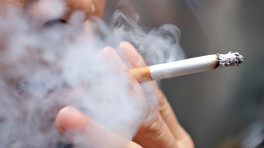What if coronavirus returns every year, like the common cold?
A paper published Tuesday in Science by Harvard University public health researchers explores that possibility, and what it would mean for Covid-19’s spread in the long term

The novel coronavirus SARS-CoV-2 appears to be similar to its close genetic cousin SARS-CoV-1.
And for good reason: The virus responsible for the early 2000s SARS outbreak is, in many ways, the closest parallel to what we're dealing with now, Wired reported.
Researchers look to it when studying how long the new virus survives on surfaces and whether it makes sense for us to wear masks. It provides a guide for how the curve of cases and deaths might bend if we all do our part and stay home. The comparison offers some hope: Social distancing and travel restrictions helped squash the SARS outbreak in about a year.
But that kind of sweeping containment has begun to look far less plausible. To predict the long-term course of Covid-19, a different analogy may be in order. What if the virus is more like some of its lesser-known family members, like HCoV-OC43 and HCoV-HKU1? The names are not as familiar, but you've likely met them before. These viruses cause the common cold. And while they're less deadly than SARS or MERS, they're peskier too; they come and go with the seasons, with human immunity waning over time. It's why we keep catching them, again and again.
A paper published Tuesday in Science by Harvard University public health researchers explores that possibility, and what it would mean for Covid-19's spread in the long term. Their conclusions are somewhat grim. If SARS-CoV-2 follows in the footsteps of these cold germs, herd immunity will be slower to build up and hold. (Herd immunity occurs when enough members of a population have either already had a disease or been vaccinated against it, stopping the flow of its transmission.) Until that happens, outbreaks would be a regular fact of life. Combined with the virus's greater severity, that would require social distancing interventions to happen again and again, to avoid overwhelming hospitals each time.
The Harvard researchers found we could be looking at being shut-ins, at least from time to time, for a long while—think 2022.
The role of seasonality "is certainly not zero," Marc Lipsitch, a professor of epidemiology at Harvard who coauthored the study, said at a press conference held Tuesday. He cautioned that seasonal variability is not the same thing as saying the virus will go away in the summer. Outbreaks could occur at any time, he noted, but those that begin in the fall might be more severe. That kind of variation could have important implications for how social distancing measures are timed.
Whether Covid-19 will mirror the transmission of coronavirus-caused colds is far from certain, the researchers acknowledge. The virus has been around for only a few months, so no one has been able to directly study how it spreads during different seasons. We also don't yet know how well immunity builds up, and how long it lasts once established. The Harvard team's models also depend in part on the rather bleak assumption that the scientific community won't develop treatments or vaccines that dull the virus's toll on health systems. All that could change, the researchers say.
In the absence of hard data about SARS-CoV-2, the cold-causing coronaviruses are useful for making long-term comparisons, says Ashleigh Tuite, an epidemiologist at the University of Toronto who wasn't involved in the study. "Are they going to be the same as SARS-CoV-2? Probably not. It's a different virus," she says. "But it's probably the best analogy that we have to work off of right now, especially thinking longer term." The paper does a good job outlining the uncertainties, she adds. It does what models do: helps us prepare for the unknown.
In their new study, the researchers start with a goal that's at the heart of all social distancing measures: How do you manage the virus's spread without running out of hospital beds? Using computer models, they gamed out potential seasonal variations, using the behavior of HCoV-OC43 and HCoV-HKU1 as a guide, and factoring in what's known about Covid-19's rate of spread and severity. They found social distancing interventions, if timed well, would likely need to extend into 2022 to get the new virus under control. Over time, as herd immunity to the virus gradually increases, those interventions could be dialed down, reducing them in both length and severity, with longer periods of relative normalcy in between.
For modeling the potential recurrence of the virus, the major questions are how much of the population gains immunity, and how quickly. Serosurveys would be a good place to start, Lipsitch believes. Widespread blood tests for antibodies to the virus would enable public health officials to study the question of immunity directly—first by measuring how many people have that immunity, and then, eventually, how long that immunity lasts. Longer immunity, or potentially even cross-immunity with other coronaviruses, would mean the disease could be stamped out more quickly.
Other, external factors could similarly help reduce the need for social distancing. That would include a vaccine or better therapies that reduce the number of people who end up in intensive care. One of the most critical factors for how stringent social interventions need to be is the nation's health care capacity. More beds and staffing, the researchers note, could help us reach herd immunity faster, simply because more people could get sick at a time without individual hospitals getting clobbered.
Contact tracing, or keeping a record of everyone an infected person has crossed paths with, will also play a role. The current idea among epidemiologists and public health officials is that, once the present surge of cases is tamed in the US, we'll switch to surveillance mode, opening up the economy again but employing widespread antibody testing and tracing people's contacts through cell phones or an army of public health officials.
But the experiences of East Asian countries like Singapore, which had initial success with contact tracing and isolation but are currently facing a resurgence of Covid-19 cases thanks to germs carried by inbound travelers, casts some doubt on how long surveillance alone can hold the line if people are not also sheltering at home. "The problem with that—as Singapore, with arguably the best public health system in the world, has discovered—is that it's very difficult to do with this infection," said Lipsitch. Widespread testing and surveillance will be important for managing cases that emerge during periods of relative calm and alerting health authorities to new outbreaks. But other public health systems, including those in the US, are far less equipped for these measures, and are still in the middle of attempting to control a surge. For now in the US, "I think distancing interventions of some sort will have to continue," he said.
Factoring in seasonality could be important for making sure those interventions are well-timed. One danger, for example, might be holding tight to social distancing measures for a long period and relaxing them just before a fresh surge that begins in the fall. Because few people would have developed immunity during the earlier period of social distancing, that would potentially mean a more dire result in the next outbreak.
Logistically, it will be difficult to do that kind of toggling. "It's not a switch you can turn on and off," Tuite says. First, the US will have to get the current surge of cases under control. Then, we'll need to have enough testing to monitor for when new cases spike again. But it will remain challenging to calibrate when, exactly, to reinstate social distancing to prepare for a subsequent surge. Society may have trouble accepting a stuttering, lurching return to normal, especially one that interrupts school schedules, political campaigns and staffing for businesses that will need to open up only to later close down. "What these models show is that this is not a one and done," Tuite says. "The next step is to figure out how we get to something that's sustainable."


 Keep updated, follow The Business Standard's Google news channel
Keep updated, follow The Business Standard's Google news channel















